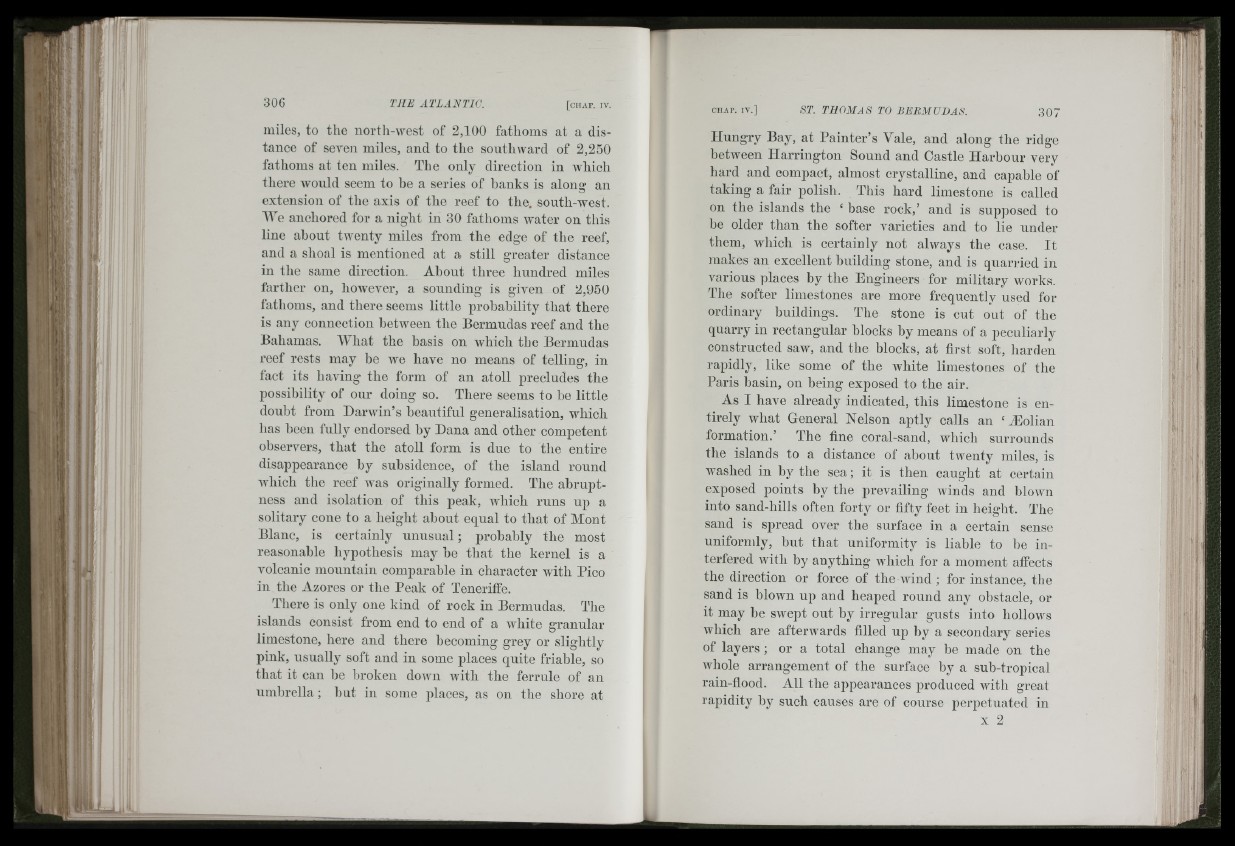
■tl
■i' ■ I
miles, to the north-west of 2,100 fathoms at a distance
of scA'en miles, and to the southward of 2,250
fathoms at ten miles. The only direction in which
there Avould seem to be a series of hanks is alonsr an
extension of the axis of the reef to the, south-west.
We anchored for a night in 30 fathoms water on this
line ahout twenty miles from the edge of the reef,
and a shoal is mentioned at a still greater distance
in the same direction. Ahout three hundred miles
farther on, however, a sounding is given of 2,950
fathoms, and there seems little probability that there
is any connection hetween the Bermudas reef and the
Bahamas. What the basis on which the Bermudas
reef rests may be we have no means of telling, in
fact its having the form of an atoll precludes the
possibility of our doing so. There seems to he little
doubt from Darwin’s beautiful generalisation, which
has been fully endorsed hy Dana and other competent
observers, that the atoll form is due to the entire
disappearance by subsidence, of the island round
which the reef Avas originally formed. The abruptness
and isolation of this peak, which runs up a
solitary cone to a height ahout equal to that of Mont
Blanc, is certainly unusual; prohahly the most
reasonable hypothesis may he that the kernel is a
volcanic mountain comparable in character with Pico
in the Azores or the Peak of Teneriffe.
There is only one kind of rock in Bermudas. The
islands consist from end to end of a white granular
limestone, here and there becoming grey or slightly
pink, usually soft and in some places quite friable, so
that it can be broken doAvn with the ferrule of an
umbrella ; hut in some places, as on the shore at
Hungry Bay, at Painter’s Vale, and along the ridge
hetween Harrington Sound and Castle Harbour very
hard and compact, almost crystalline, and capable of
taking a fair polish. This hard limestone is called
on the islands the ‘ base rock,’ and is supposed to
he older than the softer varieties and to lie under
them, which is certainly not always the case. It
makes an excellent building stone, and is quarried in
various places by the Engineers for military works.
The softer limestones are more frequently used for
ordinary buildings. The stone is cut out of the
quarry in rectangular blocks by means of a peculiarly
constructed saw, and tbe blocks, at first soft, liarden
rapidly, like some of the white limestones of the
Paris basin, on being exposed to the air.
As I have already indicated, this limestone is entirely
what General Nelson aptly calls an ‘Hiolian
formation.’ The fine coral-sand, which surrounds
the islands to a distance of about twenty miles, is
Avashed in by the sea ; it is then caught at certain
exposed points by the prevailing Avinds and blown
into sand-hills often forty or fifty feet in height. The
sand is spread over the surface in a certain sense
uniforndy, hut that uniformity is liable to he interfered
with by anything which for a moment affects
the direction or force of the wind ; for instance, tbe
sand is blown up and heaped round any obstacle, or
it may be swept out by irregular gusts into hollows
which are afterwards filled up by a secondary series
of layers ; or a total change may be made on the
whole arrangement of the surface by a sub-tropical
rain-flood. All the appearances produced with great
rapidity hy such causes are of course perpetuated in
X 2
»i1 1 i I"
- - ! , i| , ■
:i...
ft
tli; I,
T,1i:.
A i;: i.lU U
Jtlî
. fi. 'l1> , H
Si.te:W
r i t i i
jlnji !
Î i'